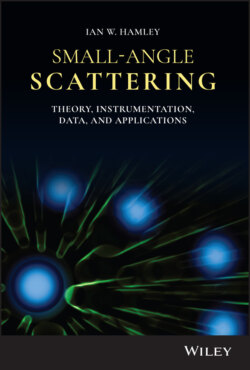Читать книгу Small-Angle Scattering - Ian W. Hamley - Страница 24
1.6.7 Integral Equation Theories, Closures, and Structure Factors
ОглавлениеThe Ornstein‐Zernike (OZ) equation is an integral equation used in liquid state theory to describe the correlation between two molecules. Specifically, the total correlation function between particles at r1 and r2, with inter‐particle separation r12 is written as
(1.73)
where g(r) is the radial distribution function. The OZ equation is [50]
(1.74)
Here c(r) are direct correlation functions and ρ is the density. This integral equation gives the total correlation function as the sum of the direct correlation and an integral over the indirect correlations involving a third particle, integrating over its position r3.
The Fourier transform of the OZ equation is written as
(1.75)
Where H(q) is the Fourier transform of h(r) and C(q) is the transform of c(r).
The structure factor is related to the pair correlation function g(r) via
(1.76)
It may be noted that this equation differs from that given in Eq. (1.32) since the spherical average is not employed, and the normalization of g(r) differs.
Equation 1.76 along with Eq. (1.75) lead to the OZ expression for the structure factor:
(1.77)
In the limit ρ → 0 the integral in Eq. (1.74) vanishes and the direct correlation function is [50]
(1.78)
Here β = 1/kBT. If βv(r) ≪ 1 Eq. (1.78) gives
(1.79)
Which is known as the mean spherical approximation (MSA), used to evaluate the OZ equation.
The OZ equation can be solved using closure relationships for c(r) such as the hypernetted chain (HNC) approximation and the Percus‐Yevick (PY) approximation. The HNC equation is [50]
(1.80)
or
(1.81)
This simplifies to the MSA in the limit r → ∞ since h(r) → 0 in this limit, but generalized for any density.
The PY closure equation is given by
(1.82)
This is obtained from an expansion of the HNC closure [50].
Exact solutions of these closure relationships are known, for instance using the PY approximation for hard spheres [50] or the Carnahan‐Starling approximation gives the expression in Eq. (1.38).
Further information on integral equation theories for liquids is available elsewhere [51].
